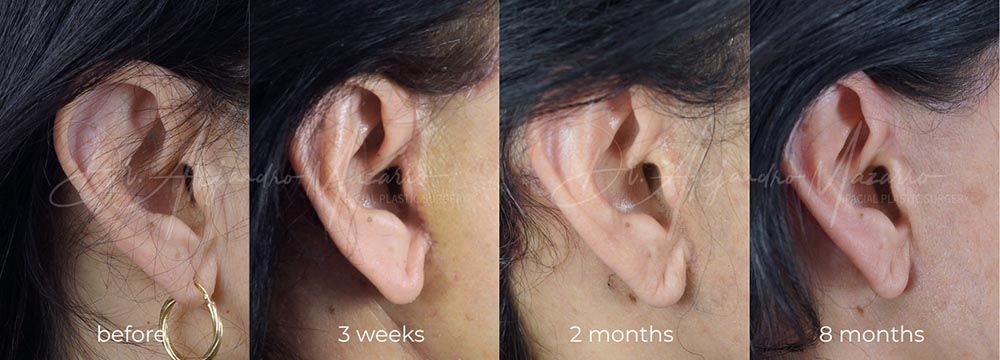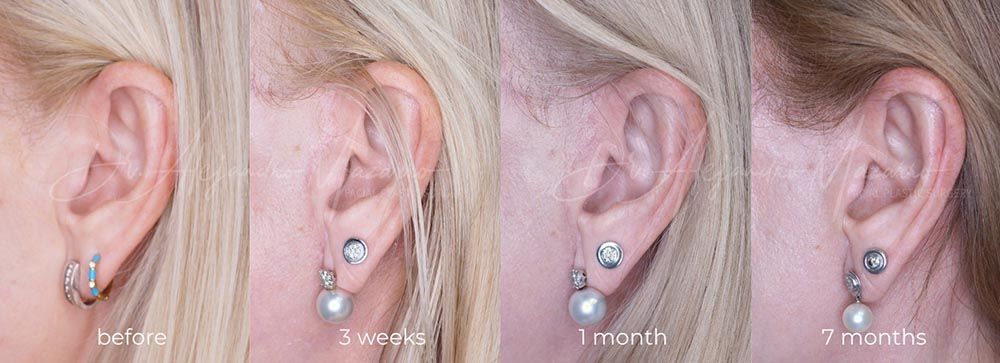Facelift scars: Everything you need to know
Are you concerned about Scars after a Facelift?
If you’re considering a facelift, one of your first concerns is likely:
“Will the scar be visible?”
And that’s completely understandable.
The goal is not only to look younger, but to feel confident in your reflection without anyone noticing that a procedure has been done.
Let me explain why, with the right technique and proper aftercare, scars should not be a concern.

What Makes the Deep Plane Facelift Special for scars?
Throughout my career, I’ve worked with various facial rejuvenation techniques.
And if there’s one technique that stands out above the rest for its natural, long-lasting, and refined results, it’s undoubtedly the Deep Plane facelift.
Unlike more traditional methods (which work superficially on the skin), the Deep Plane technique operates at a deeper level.
We reposition the muscular tissues and facial ligaments, returning them to their original position, without applying any tension to the skin.
The result?
Because there’s no tension on the skin, healing is much better compared to a traditional facelift, achieving natural rejuvenation with almost imperceptible scars.
Where Are the Incisions Made in a Deep Plane Facelift?
The placement of the incisions is not a simple technical detail.
It’s a critical part of the aesthetic result.
And it requires anatomical knowledge, aesthetic sensitivity, and significant surgical experience.
For the Deep Plane facelift, the incisions are strategically placed in areas where the anatomy of the face naturally hides them:
- In front of the ear, following the natural fold in that area. The incision can either be pretragal (in front of the cartilage) or retrotragal (behind the cartilage).
- Behind the ear, following the retroauricular fold, often extending towards the scalp. Over time, this incision is hidden, even if you wear your hair up.
- When working on the neck, a small incision is typically added under the chin.

Pretragal vs. Retrotragal incision: which is better?
The incision in front of the ear can either be pretragal (in front of the cartilage) or retrotragal (behind the cartilage).
While it might seem like the retrotragal incision is always better (since it may appear more hidden), it largely depends on each case.
Generally, I prefer the retrotragal incision. However, if the tragal cartilage has a pronounced angle or there’s a pretragal fold, the pretragal incision is often better disguised.
What factors influence facelift scar healing?
One of the great advantages of the Deep Plane facelift is that, since no tension is applied to the skin, scars heal better, with finer and more discrete lines.
But good healing doesn’t only depend on surgical technique.
There are also personal factors that need to be considered to maintain realistic expectations.
Here are the key factors that influence healing:
Each patient heals differently.
And skin type plays a significant role:
- Thicker skin or skin with a good collagen level generally heals better and leaves less visible marks.
- However, even with delicate or fair skin, excellent results can be achieved with a proper care routine.
While it’s true that healing tends to be faster in younger patients, age alone doesn’t mean worse healing.
What really matters is the overall health and, most importantly, a proactive approach during the post-operative period.
Smoking seriously compromises healing, both aesthetically and medically.
That’s why I always ask my patients to stop smoking at least 2 months before and after the procedure.
And the difference is noticeable.
This is where your role becomes crucial.
Protecting the skin from the sun, keeping the area clean, applying the prescribed products…
Every little action contributes to a better result.
I will guide you throughout the process, but your involvement is key to success.
What happens to facelift scars over time?
It’s normal to be concerned about the scars at first.
During the first few weeks, they may appear slightly red or swollen. This is completely normal.
However, with a little time and basic care, the scar will become thin, clear, and practically invisible.
After a month, the change is noticeable, and at three months, it’s nearly imperceptible. Generally, between six months and a year, many patients tell me they have to look closely in the mirror to even remember where the incision was.
Want to see real cases of how Deep Plane Facelift scars evolve in my hands?
Check out the photo gallery to see the typical progression of scars.
Still have questions?
Book an appointment and let’s assess your case together.


Do you want to check the evolution of the global result?
Click here to discover the recovery process of a Deep Plane Facelift with a dedicated specialist.
Dr. Mazarro – Deep Plane Facelift Expert in Barcelona
Taking the step to have a facelift isn’t easy. Behind it there are usually months —sometimes years— of doubts, of looking at yourself in the mirror and feeling that your face no longer reflects how you feel inside.
Choosing a specialist to entrust your face to is an important decision. Your face is how the world sees you, the reflection of your identity.
That’s precisely why years ago I made a decision: to specialise in Facial Lifting, a surgery that requires the utmost precision and deep knowledge of facial anatomy.
Because I’m firmly convinced that only through specialisation is it possible to achieve the results you’re looking for.
Today, after almost 10 years of experience in facial lifting, I’m certain it was the right decision.
And you, don’t you want the peace of mind of putting your face in the hands of a specialist?
Book an appointment
Fill out the form or contact us via WhatsApp (+34 644 534 515) or email (info@drmazarro.com).

Do you live far away or prefer an online consultation? Contact us and we’ll guide you through the process.
We inform you that the personal data you provide by filling out this form will be processed by ALEJANDRO MAZARRO CAMPOS. The purpose of collecting and processing the requested personal data is to send information related to your consultation inquiry via e-mail, SMS, WhatsApp®, or phone call. Personal and contact data may be shared with the respective marketing/customer service teams of the clinic(s) where Dr. Mazarro collaborates to contact the applicant. The user also consents that their contact details may be processed by ALEJANDRO MAZARRO CAMPOS for the purpose of providing information through electronic or other means about new products and services related to his activity for advertising and promotional purposes. By checking the acceptance box, you are giving your express and legitimate consent for your data to be processed in accordance with the purposes of this form described in the privacy policy. You may exercise your rights of access, rectification, limitation, and deletion through the email address info@drmazarro.com.
Controller: Alejandro Mazarro Campos.
Purpose: respond to your inquiry.
Legal basis: user consent.
Recipients: the data you provide will be stored on Google Workspace servers (my email provider).
Rights: you can always access, rectify, limit and delete your personal data.
We take care of everything — explore our out-of-town patient protocol and book a video consultation in your preferred language.


Would you like to learn more about different types of facelift surgery?


Curious about what recovery looks like after a facelift with Dr. Mazarro?





The information you are looking for to plan your surgery

Where are the scars located in a Deep Plane Facelift?
Incisions are usually placed around the ear, in areas such as the tragus fold, the hairline, and behind the earlobe. They are designed to remain hidden by natural facial shadows or the hairstyle.
Are facelift scars very noticeable?
No. If the surgery is performed correctly, scars become almost invisible after a few weeks. Their strategic placement and meticulous suturing allow them to blend seamlessly with the skin.
How long does it take for a facelift scar to heal?
Healing varies, but typically scars are closed and secure within 10–15 days, difficult to notice after 3 months, and by 6 months many patients can barely remember where they were.
Can scars be prevented from becoming visible?
Following postoperative instructions is essential: avoid direct sun exposure, use scar cream, and don’t smoke. These steps help scars heal better and remain discreet in the long term.






